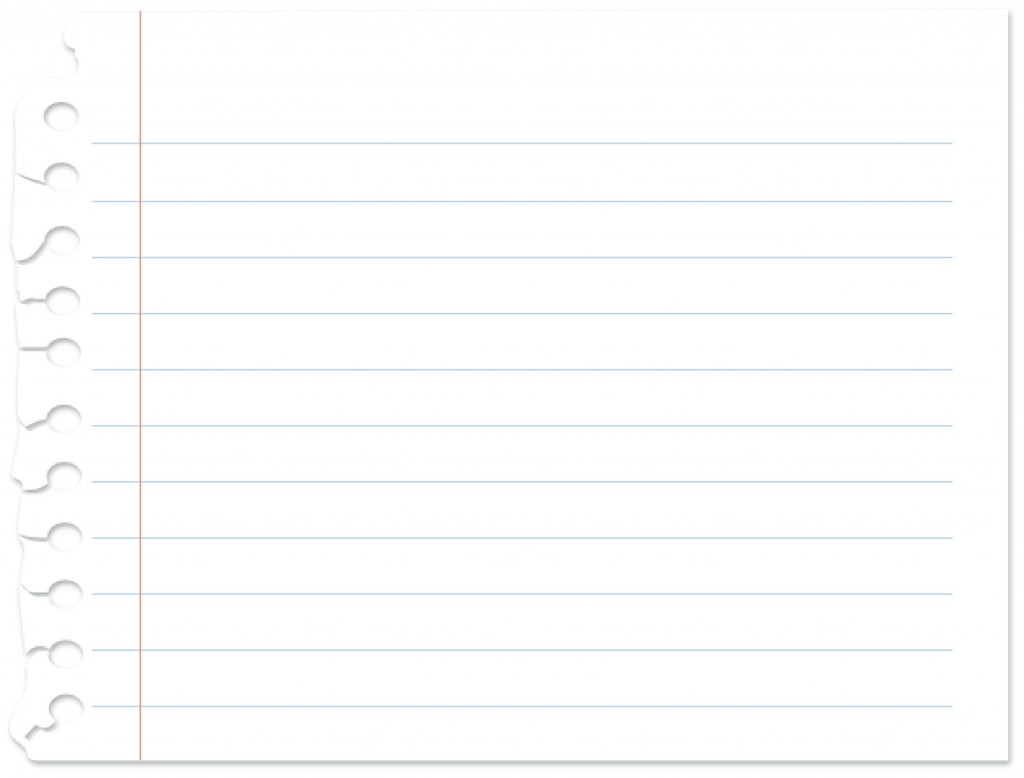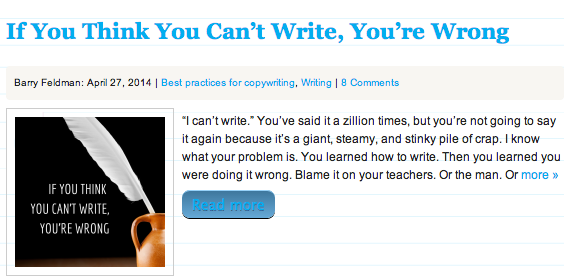Look at this monster.
It’s a blank page. It’s not a rattlesnake. It’s not an axe murderer. It can’t hurt you. How could it creep you out so badly?
The answer can only be one thing: you don’t know what to do. You feel helpless. That’s a shitty feeling.
I’m going to help you. I’m going to tell you what to do.
Write.
That’s right. Write something. Anything. It might be awful. It could be truly amateurish. It doesn’t matter. Write. Right now.
Let me talk you through this, a fictitious, but very real enactment. I’ve done it many times before and it usually goes something like this…
I ask the obvious question, “What’s the problem?”
I get the obvious answer, “I don’t know where to start.”
Next question: “What are you trying to say?”
Next answer: “Well, we’re hosting an event, so I want to tell the prospects who have indicated some interest in our solution the value of attending. They’ll learn a lot and it won’t cost a dime.
My turn: “Well there you go. That’s great. Write that down.”
Response: “Write what down?”
“Write what you just told me. It sounded pretty good.”
“Seriously?”
“Seriously.”
You’re out of order.
You came in search of the prescription for this writing disorder of yours and the big secret I offer you is “write?” It sounds kind of lame.
Maybe you take me for a poser now. Not so fast my friend.
Am I telling you the secret to becoming a writer is simply “start writing?” No, I’m not. However, I’m telling you what your biggest problem is.
You’re going about this backwards. You’re doing the tasks in the wrong order. Writers write first and edit after.
When you stare for hours at a blank page while each tick of the clock gets progressively louder and the sweat starts to pour, what you’re really doing is editing.
The thoughts aren’t getting transferred to the page because there’s an editor in your head telling you “this stinks.” And it probably does. Let it stink.
Your lack of experience has you obsessing with details when you shouldn’t be. You’re trying to fix your work before there’s any work to fix. You’re hunting for flaws.
If you’re going to be an editor and a writer at the same time, your page could remain blank for all eternity.
If you can’t write, your foremost foe is perfection paralysis. You need to slay that nasty beast.
The hardest part of every task is starting.
“The first draft of anything is shit.” ― Ernest Hemingway
You started. Look at the page now. It’s not blank. You should feel quite a bit better. Now stop looking at it and get back to work. Put the next thought down and then the next. Keep going until they’re all there in all their smelly glory.
Of course, you’re not going to publish, share or sign the thing yet. It’s a first draft. Now you’re going to edit.
Welcome to the writing process.
Iteration is liberation.
If you think you’re reading the first draft of this manuscript, think again. I wrote it then I edited it. Then I edited again.
Writing is an iterative process. When you arrive at the point where you run out of ideas for improving what you wrote, you’re done. It may not ever be perfect, but you’re going to make it better with each pass thanks to the magic key: delete.
All writers depend on striking, deleting, backspacing—some form of cutting. Prolific writers get used to pruning their prose. It’s a skill that takes practice, to be sure. Sometimes there’s pain associated with dispatching your babies to the trash can. But this is the way it works.
In your journey as a writer you’ll come to know other writers and talk about your craft. I can assure you you’ll never hear any accomplished writer deny their drafts become more solid when they slash and trash.
Realizing this is endlessly liberating. You need to feel free to barf ideas on the page. Make a glorious mess to get started. Clean it up to get it done.
Here are 12 tips to help you delete, edit and improve your writing.
1. Cut “that” out
I can always spot an unprofessional writer by the repetitive and unnecessary use of “this,” “that,” and “these.” A specific pet peeve of mine is finding them as the first word of sentence. When you review your drafts, remove every instance of these (that) you can. See what I mean?
2. Break up long sentences
Long sentences run the risk of losing your reader. When you put several ideas in one sentence, break them up into separate sentences. If you spot a comma-heavy sentence, try to give each idea its own sentence.
3. Reduce redundancies
Get to the point by avoiding redundancies such as “violent explosion” or “new beginner.”
4. Lose the nothing phrases
“In order to…” and “needless to say” are two examples of common phrases that add nothing to your story. Find phrases that are simply filler and axe them.
5. 86 “very” and “really”
“Very” and “really” are really very useless words.
6. Purge the passive voice
Your writing gets dull when you employ passive phrases such as “It become known to me.” Go with an active voice. “I discovered…”
7. Use power verbs
First drafts tend to include many wimpy verbs. Make it a point to replace common verbs such as “get” with less common and more powerful verbs such as “seize” or “command.”
Look at my word choice above. “Use” is predictable and boring. Would “Choose” or “Employ” or “Apply” pumped up the prose? Notice every subhead in this list begins with an action.
8. Refer to people as “who”
Barry is the guy that can help you with your editing. “Who” is how you refer to someone. Correction: Barry is “who” you need to help you with your editing. Improvement: Barry will help you with your editing.
9. Avoid the “today stamp”
“Currently” is a stinker. “Nowadays” is too. Starting off with “Today” or “In today’s…” are other meaningless throw-aways.
10. Eliminate “there is” or “there are” at the beginning of sentences
There are lots of ways to start your sentences more interestingly than “there is” or “there are.” Start your sentences with a bang.
11. Let’s get friendly
Let us become friends. Let’s become friends. Let’s get friendly. I believe contractions make your writing more friendly and familiar. And, of course, striking forms of “be” tends to liven up the copy.
12. Steer clear of the ing trap
“We were starting to …” Whenever you see an “ing” in your copy, you can probably improve the line. “We started” is a more exciting way to start.
Some of the editing tips came from Copyblogger and AlexisGrant.com.
This post is sequel to:
If You Think You Can’t Write, You’re Wrong.




![How to Write Powerful Headlines for Your Online Content [Infographic] How to Write Powerful Headlines for Your Online Content [Infographic]](https://feldmancreative.com/wp-content/uploads/2019/04/Screen-Shot-2019-04-19-at-5.38.54-PM.png)



Comments
Stephen Lahey
Great tips, Barry! My podcast has been going well, and now I want to create some useful blog content. I have to admit that I’ve been feeling intimidated at the prospect of being judged as just another blogger. Perhaps I need to drop the perfectionist attitude. Thanks for the nudge! 🙂
Elizabeth
Great, fantastic, readable and exciting! I love the written word. I would like to add to the “list of peeves”. “Firstly” …there is no such thing. A sentence should read, First….. Secondly…..Finally.
Avoid Social Media Blunders with Proper Copy Editing
[…] listing copy editor’s pet peeves. One such list is contained in Barry Feldman’s article, Copy Editing Tips: Delete + 12 More Ways to Improve Your Writing. My favorite tip from this list is something that I catch myself doing again and again is to use […]
Top Content and Lessons Learned in 2014 | Drip Logic
[…] Copy Editing Tips: Delete + 12 More Ways to Improve Your Writing […]
Jose V. Basile
None can write anything good without doing edits.We may divide our editing process into few steps.After finishing our writing, we should try to reduce the same words using many times. Secondly, we should try to find out the verbose, dialects etc and then remove it. Thirdly, we may try to remove all common word. Fourthly, We should again check the resources’
authenticity.Latterly many people ask other that do my research paper or do my homework or write content for me or something like that. I have suggested them to learn writing and be a self-sufficient writer. Because it is very easy if we get proper guideline and monitoring from the expert. Thank you.
Allison
Very informative post. Thank you!!!